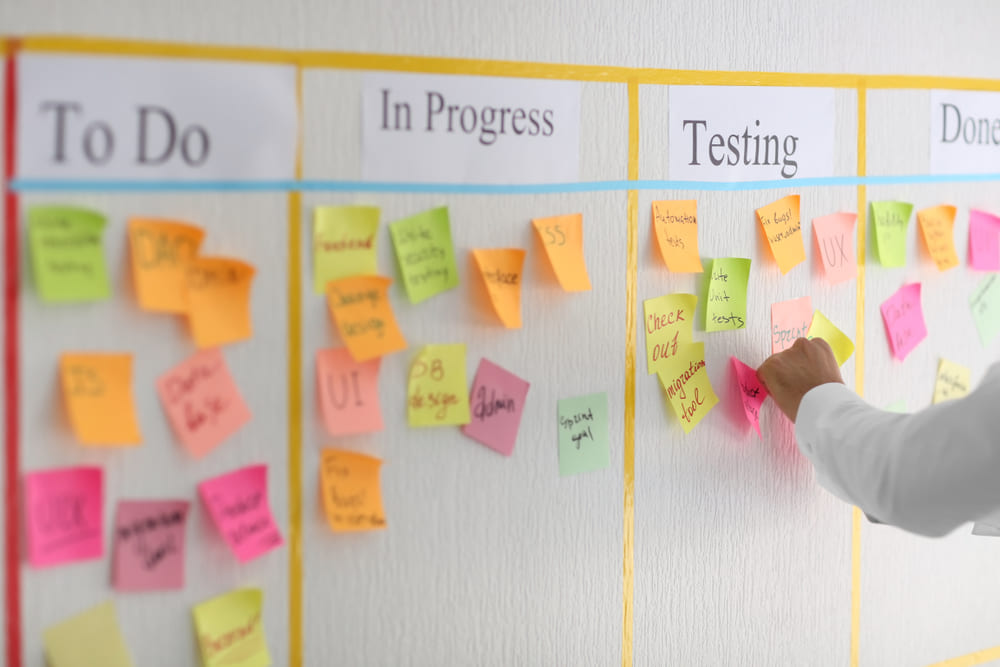
Agile Project Management: Best Practices and Methodologies

As we have observed over the years, agile project management has been growing in popularity over the last few years thanks to the flexible and adaptive nature of the methodology. It’s perfect for group projects that require short completion times with minimal room for error and the necessity of quick reactions to changes.
The biggest advantage that comes with using this style of project management is how the enterprise is divided into smaller chunks that can be tackled in a swift and efficient manner. Thanks to this, any problems can be dealt with right away and any changes that are needed can be delivered in a relatively quick manner.
Beyond that, however, are the best practices that can make this excellent method of managing projects even more effective. After all, agile software development is only as good as the systems that you have in place to truly take advantage of it.
What is Agile Project Management?

What is agile project management and what is agile methodology? We note that the core idea behind agile project management is efficiency and flexibility. This is accomplished by basically breaking up tasks to smaller, more manageable parts that can be tackled one piece at a time.
The goal of the agile process is to prevent teams from getting overwhelmed with the enormity of the undertaking by streamlining the process and allowing specializations to take the lead. This allows for a considerable number of benefits that include much more reliable scheduling and providing results that can be seen right away.
More importantly, it also allows members to react to sudden changes, mistakes, and adjustments in a more coordinated manner. By addressing issues that come up as they do on a smaller scale, the time saved will stack and the project can be finished much faster.
This is the reason we observe that agile methodologies are so popular in industries like software development where changes can occur quickly based on the market or client demands.
Read also: How to Hire a Mobile App Developer.
Why is Agile Project Management Popular?
There are many benefits that come with using agile project management for any endeavor, but it is especially effective for large projects with multiple members. A lot of this is due to the fact that the end product that comes out will almost always be better than what would have been the result without it.
For some context, however, the following are the most critical advantages that come with using agile development methodology:
- Superior end product
- More control
- Increased flexibility
- Makes the most of specialized skills
- Smoother team interactions
- Timely response
- Less stress
It would not be wrong to say that the agile development process is one of the best ways to avoid conflict in team projects either. Because of how tasks would be set up through this method, everyone would basically have a job that they can complete in conjunction with everyone else.
On that note, agile project management on its own will not solve all of the problems that have been known to crop up when multiple people are working on a single project. This is why it is always worth knowing what the best practices are.
Best Practices for Agile Project Management

Agile project management best practices are simply steps that you can take that will bring about the best possible result of any given task or series of tasks. These are essential for those who are only working together for the first time or are not yet familiar with how the method works.
These best practices and agile methodology steps are meant to optimize the workflow, minimize mistakes that could waste time, and make adjusting to changes less of a hassle. To that end, please refer to the following:
- Iterative Development – One of the core principles of agile project management is breaking down big tasks into smaller chunks that are easy to finish and require less time to get done. Hence, why iterative development is a key best practice to consider.
By breaking projects up into smaller pieces, it becomes much easier to focus on that particular part of the endeavor, which requires a much smaller amount of concentration. This is basically a psychological approach where the team invests in bite-sized success.
From there, all you really need to do is keeping finishing each piece in a timely and efficient manner until you eventually end up finishing the project itself. Whether that’s agile programming or something else.
However, it’s worth pointing out just segmenting projects is not enough since it needs to be done with more forethought, as well be discussed later on in this piece.
- Short, daily meetings – It is very important that the team touches bases every chance that they can get and the best way to do this is through daily meetings. These meetings don’t need to be that long either since they can be brief, lasting only a few minutes. This is just a part of agile methodology definition.
The only thing that these meetings are meant to accomplish is to keep everyone abreast of what is going on and to inform members of any changes that have occurred. In order to make sure that there is a smooth workflow, all members should be able to adapt in quick fashion.
This will only be possible if everyone knows exactly what is going on. Of course, office notes can do this, as well. However, there is something to be said about being able to get information through those you work with directly.
- Value identification – It was already mentioned that the point of agile project management is breaking down tasks into smaller pieces. However, it best to do this through the identification of value. That is to say, each smaller task should be grouped in accordance with their worth and the level of effort they will require.
This will allow the work to be a lot more manageable and for the results to be a lot clearer so that the team knows exactly where they are. From there, it then becomes easier for the team to see the fruits of their hard work, which provides more tangible proof of their efforts.
When it comes to the questions of what is agile and why agile, those go a long way to answering them.
- Using tools – Managing a team is something that can be done in a wide variety of ways, but one of the most important facets of the job is to keep everything proceeding smoothly. This can be done much more easily with the help of tools that are geared specifically for making tasks easier to accomplish and keeping members informed.
Thanks to the existence of a wide range of management tools, it becomes less of a hassle to assign jobs to the right people. From there, project managers will be able to keep track of how everything is going and the team members themselves will know exactly how the project is progressing.
Using tools is less of an option these days and more of a necessity, especially if there is remote work involved. Even if all members of the team are in the same location, it’s just easier when leaders are able to keep track of jobs without having to get up from their desks. Less time is wasted and everyone is on the same page.
- Constant communication – Even with the help of tools for managing teams and the tasks becoming smaller than they originally were, it is still encouraged that constant communication is maintained. This means that using messaging apps or platforms will also need to be used.
Even something as simple as getting a summary of a team member’s progress for the day is needed. Checking up on their conditions is important, as well. Asking them if they need more help or if they have suggestions would be quite beneficial.
After all, this is a team effort and everyone is bound to have their own specialties. It would be a waste of talent and resources not to make the most of what everyone has to offer. This is the agile approach.
- Visualization – Based on studies and just basic human psychology, visuals make it much easier to understand what the team is trying to accomplish and how they could be accomplished. To that end, it would be advised to have visual aids to help when making presentations.
When everyone on the team can appreciate exactly what the goals are by showing them via images, infographics, and charts instead of just words, a deeper understanding can be accomplished. This would then help get everyone on the same page.
Even if agile project management is already effective at keeping team members focused, it is always advised to make use of every reinforcement tool as possible. This way, there will be fewer delays, misunderstandings, or issues arising from a lack of motivation.
- No work left unfinished – Agile project management is basically a method of making sure that every single task is done before moving on to the next one. As such, it would be best to make sure that you leave no task unfinished because this can create a snowball effect that will be detrimental to the project.
In a way, this particular management approach is like putting together a jigsaw puzzle. Except the pieces will need to be created first before they can be put in place. If a single piece is unfinished, the entire puzzle will be jeopardized. This issue becomes bigger if there are multiple pieces that are left half done.
- No waste – It’s very important that you plan your project out so as to reduce as much waste as possible. That is to say, a waste of time.
Remember that the core tennet of agile project management is efficiency. Remove unnecessary steps, goals, and resources that will only serve to drain you.
- Feedback – Always provide feedback on progress and performance whenever you can. You don’t necessarily have to keep harping on mistakes. However, it is important that your team members learn when they mess up.
Don’t step in every time something goes wrong either. It is just as essential for your team members to be able to stand on their own.
- Constant innovation – If things can be improved, there is no reason for you to ignore the possibility. Unless time constraints prevent you from doing so, constantly innovating your methods is encouraged.
This means constantly finding ways to reduce mistakes, improve the rate of success, and mitigate risks.
- Tests – Testing is essential in making sure that you are actually getting the results you need. Every time a task is done, it is crucial that it is tested for errors so that they can be fixed right away. This is a big part of agile practices.
- Product update – Whenever a task is done that can be showcased and presented, it is important to do so. This is to make sure that team members are kept apprised of how the project is progressing and how close the goal is.
- Keeping the flow smooth – A smooth workflow helps keep progress steady and the timeline easier to forecast. The smoother the team can work, the easier it is to have a good idea of how fast tasks can be finished and the project finalized.
- Backlog updates and records – Any remaining tasks that need to be completed need to be organized in a neat manner so that they can easily be assigned to the best people to take care of them.
Letting team members know which tasks have yet to be completed will also allow them to volunteer when they have the chance to.
Conclusion

So, there you have it. Those are the best practices we have observed firsthand will help make agile project management even more effective. In our experience, making sure that these steps are taken when undertaking projects for software development or pretty much any task will be a good use of time and resources. So, for anyone who wants to use this management method, go ahead and take a look at those now.
Recommended articles


